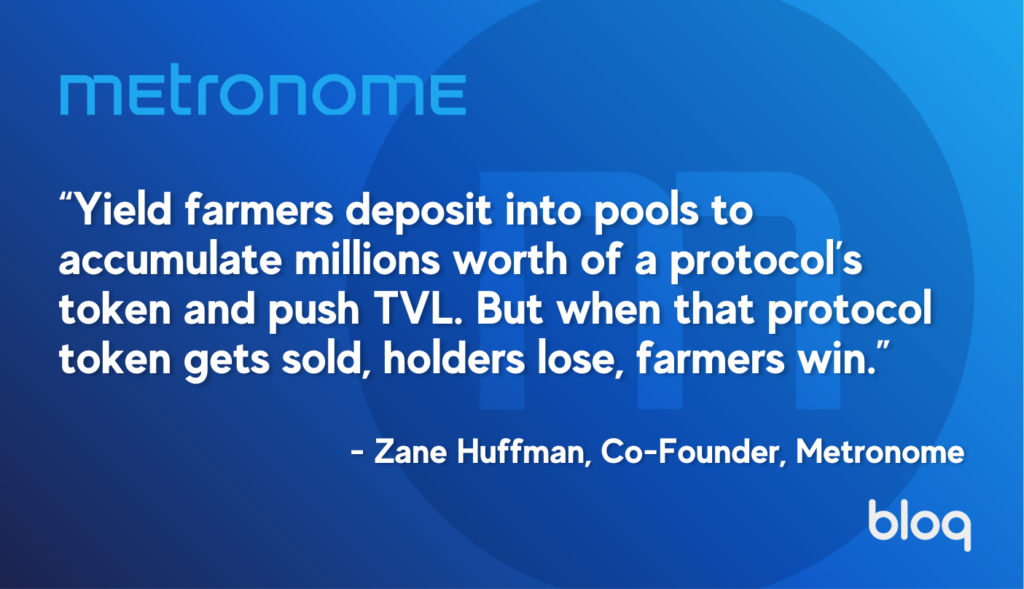DeFi is notoriously fickle, with users weaving in and out of various protocols and positions. Lowering user friction is a big reason why our ecosystem exists. But it also introduces another problem: holders of a DeFi protocol’s token must be incentivized to hang around.
Bloq’s DeFi team — creators of the Vesper (yield farming) and Metronome (synthetics) platforms — has been working to overhaul their tokenomics to accomplish exactly this. Metronome Co-Founder and Bloq Chief DeFi Strategy Officer Zane Huffman wants users of Metronome’s yield-accelerating “Smart Farming” capabilities “to lockup the token and, therefore, take an active interest in the platform.”
HODLing Has Its Privileges
He described typical DeFi arrangements as too-often pitting the interests of the holders against the yield farmers — a scenario that puts parties at odds. He prefers both users working toward sustainable, profitable purposes.
“Yield farmers deposit into pools to accumulate millions worth of a protocol’s token and push TVL,” said Huffman. “But when that protocol token gets sold, holders lose, farmers win.”
The tokenomics approach for the Metronome token (MET) intends to make the two parties one-in-the-same in terms of incentives. This means that the self-interested yield farmer is doing good things, not bad things, from the perspective of the Metronome DAO maximalist.
[How does the Bloq DeFi’ team’s tokenomic approach bridge this gap? Read more.]
In the new framework, the longer a holder locks up MET as “esMET,” the greater weight they hold across the platform. This means that holders earn additional benefits such as marketplace fee reductions, which is especially helpful in arbitrage. esMET holdings will then contribute to a user-tiered privilege system. Holders also benefit from multiplied governance weight.
Accelerating Smart Farming
Smart Farming describes Metronome’s capability for turbocharging DeFi performance by minting synthetic assets from productive collateral and looping that position to obtain even higher yield as well as more esMET.
“It’s a holistic strategy to give big APY to users locking up the most MET and providing the most liquidity,” Huffman noted.
Along the lines of incentivization, the goal going forward is to redeploy different pools with different parameters, such as Isolated pools with higher leverage (potentially higher yield) and pools gated behind esMET holdings.
This effectively turns Synth into the most powerful, higher leveraged, lowest-fee pools gated to esMET lockers. And while the general pool will still exist, public versions of the higher leverage pools will be made available for participation at higher fees.
“Pick your poison,” Huffman said. “Pay higher fees or buy and lock up MET tokens. In both cases, Metronome DAO wins and users win, too.”
Locked VSP
Vesper, too, is undergoing a tokenomics transition. Today, holders of the Vesper token (VSP) deposit in the governance pool to receive a share of the protocol revenues. Vesper intends to gradually migrate from this framework to “locked VSP” or “esVSP.” Similar to how Lido’s Staked ETH allows people to trade otherwise locked ether, the esVSP scheme enables users to trade their locked VSP as ERC-721 tokens in the open market, providing flexibility while still rewarding long-term community members.
Revenue for an esVSP holder depends on weights, VSP the holder has locked and for how long (from one week to two years), with a maximum multiplier of 4x. This carrot (in addition to the stick of early withdrawal) keeps users committed to the Vesper ecosystem. All fees then return to the Vesper DAO Treasury.
Projects are shaped by the environment from which they emerged. The best projects never stay that way — they change to reflect and anticipate current and future requirements. Bloq’s DeFi team has worked hard to ensure that Vesper and Metronome are ready for the future, wherever that leads.








